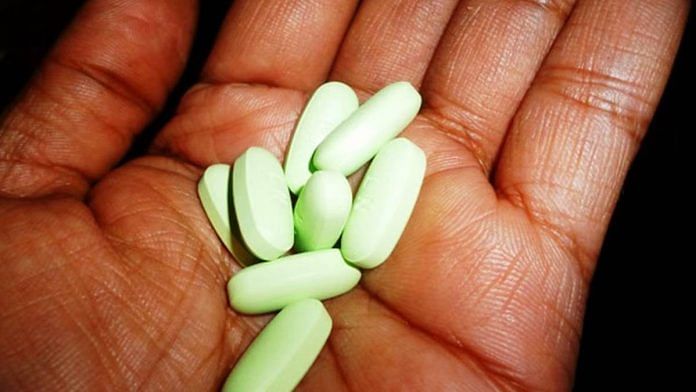New Delhi: No antibiotics for patients before diagnostic tests and limiting empiric antibiotic therapy, when the pathogen is unidentified, to seriously ill patients — these are some of the recommendations by the National Medical Commission (NMC) to faculties and senior residents in medical colleges across India.
In its bid to check the rise in antibiotic resistance, the NMC — the regulator for medical education and doctors — emphasised prescribing appropriate antibiotics or antimicrobials to patients based on clinical evaluation and most likely pathogens. The regulator sent its 156-page guidelines — National Action Plan on Antimicrobial Resistance (NAP-AMR) Module for Prescribers — to medical institutions 14 June.
ThePrint has a copy of the guidelines, which also recommended antibiotics after considering the antibiogram — the profile of antibiotic susceptibility testing results of a specific microorganism to a battery of antibiotics.
The guidelines come months after the Director General of Health Services under the Union health ministry asked doctors to specifically mention the indication, or reason, every time they prescribe an antibiotic to a patient.
The World Health Organisation (WHO) estimates that the infectious disease burden in India is among the highest in the world, with inappropriate and irrational use of antibiotics leading to an alarming rise in the development of antimicrobial resistance (AMR).
AMR occurs when bacteria, viruses, fungi, and parasites no longer respond to medicines, making people sicker and increasing the risk of spread of infections that are difficult to treat, illness, and death. Some pathogens, which have turned antibiotic-resistant, cause urinary tract infections, pneumonia, tuberculosis, sepsis and ventilator-acquired infections.
According to an analysis by the University of Washington and the University of Oxford, while AMR represents a global challenge, its burden is particularly huge in India, where, in 2019, there were 2,97,000 deaths attributable to AMR and 10,42,500 deaths associated with AMR.
“The idea behind developing a comprehensive module on AMR for medical colleges is to prompt medical professionals to acquire the requisite knowledge and skills along with a positive shift in attitude towards responsible antimicrobial use,” said an NMC official who was part of the panel that has prepared the guidelines.
“All the key aspects of antimicrobial resistance such as clinical approach for prescribing antimicrobials, microbiological diagnostic SOP, and interpretation of antimicrobial sensitivity results have been taken care of in these guidelines,” said the official, who did not wish to be named.
A professor in microbiology, attached to a government hospital in Delhi and associated with framing the guidelines, said they aimed at promoting the culture of responsible microbial use in medical colleges, where future doctors also get training.
These guidelines come against the backdrop of persistent reports of misuse of antibiotics, such as the overuse of Azithromycin during COVID-19 in the country by both individuals and prescribing doctors.
The module by the NMC comes at a time when the WHO just released a report on antibacterial agents, including antibiotics, in clinical and preclinical development worldwide.
While the number of antibacterial agents in the clinical pipeline has increased from 80 in 2021 to 97 in 2023, the report said, there is a pressing need for new, innovative agents to treat serious infections to replace those becoming ineffective due to widespread use.
Of the 32 antibiotics under development to address WHO’s bacterial priority pathogen list infections, only 12 can be considered “innovative”, with four of these 12 active against at least one WHO ‘critical’ pathogen, i.e., the disease-causing agents that are resistant even to the last resort antibiotic available, according to the report.
Also read: Admitting to slip-ups, Modi govt looks to revise 2025 target for tuberculosis elimination by 2-3 yrs
Hospitals should have an antimicrobial policy
The pathogens are developing resistance mechanisms, making it difficult to treat common infectious diseases like pneumonia, tuberculosis and foodborne diseases, according to the NMC.
The prescription of antibiotics depends on various factors, including socio-cultural and -economic factors and the beliefs of patients and professionals about antibiotic use, it said.
“The shortage of appropriate diagnostic tools, the insufficient regulatory policies of the country can further cause an increase in over-the-counter antibiotics. Medical professionals have to be prepared appropriately in order to face the challenges of antimicrobial use in everyday clinical practice,” the guidelines underline.
Also, before prescribing antimicrobials, doctors are advised to make a clinical diagnosis based on accurate history taking and thorough clinical examination — which may help select the right test for the right patient.
“A clinical diagnosis also helps in predicting the most likely organism causing a clinical syndrome. The sample must be collected before the start of antimicrobials,” said the recommendations.
The guidelines also said that recording cardinal symptoms of systems — fever, cough, sputum, breathlessness, haemoptysis, or chest pain — may suggest an infective respiratory illness like pneumonia.
“The decision to treat with antibiotics should be made by the presence of severity and laboratory report of sputum and culture examination. Jaundice and abdominal pain may be present in medical conditions like viral hepatitis, alcoholic hepatitis, leptospirosis, malaria, dengue, etc., or in surgical conditions like choledocholithiasis or cholangitis,” it said.
Prescribers are advised to take a detailed history of any recent travel, drug abuse, blood transfusion, and recent surgeries to narrow down the differential diagnosis.
Additionally, the guidelines spell out that empiric antibiotic therapy, i.e., prescribing antibiotics without knowing the exact pathogen, must be limited to seriously ill patients.
“This choice should be based upon institutional or local antibiograms,” the guidelines have said.
The NMC has also stressed that a hospital antimicrobial policy may be crucial to minimise the morbidity and mortality due to antimicrobial-resistant infection and could help preserve antimicrobial agents’ effectiveness in treating and preventing communicable diseases.
“The policy must define prophylaxis, empirical and definitive therapy and must incorporate specific recommendations for the treatment of different high-risk/special groups such as immunocompromised hosts; hospital-associated infections and community-associated infections,” the regulator said.
(Edited by Madhurita Goswami)
Also read: Ultrasound that doesn’t reveal sex of foetus in the works & what it means for pregnant women






